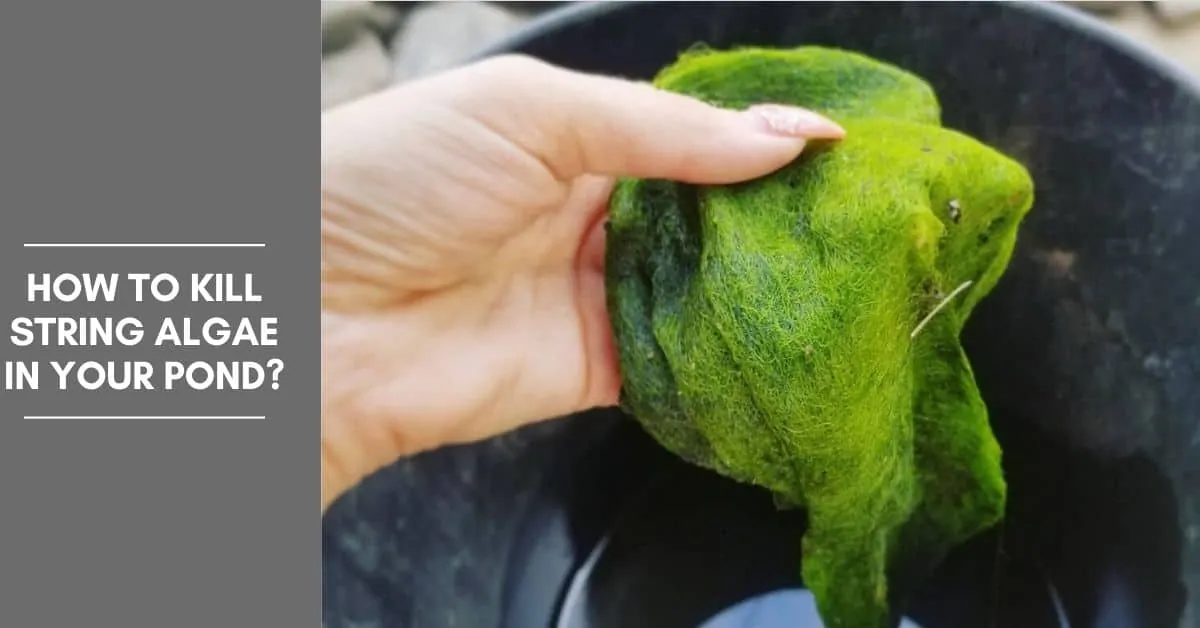Today I’m gonna talk about algae – specifically algae that you will find in a typical koi and goldfish pond in your backyard. The specific type of algae that I’m gonna talk about today is stringy fuzzy filamentous algae. Goes by a lot of different names, but basically it’s any type of algae that you can physically grab a hold of, it differs from green water algae, but stringy fuzzy type algae can grow on the surface, they can grow down deep in the pond, they can grow in a pond with full shade, that can grow in a pond it’s full sun.
Is it Normal to Have String Algae?
The first question I get a lot about these stringy fuzzy type algae is – is it normal? Should I see this kind of algae in my pond? and the first answer is yes, it’s totally normal. We see these types of algae in pretty much every single koi and goldfish pond.
The reason that you see these types of algae in the pond, is because of access nutrients. Specifically, excess nitrates. Nitrates are a byproduct of the biofiltration process. In the biofilters, beneficial bacterial enzymes colonized, and they get rid of the ammonia to keep your fish happy.
The byproduct is nitrites, but there’s another type of beneficial bacteria that eats up all the nitrites, the byproduct of that is nitrates. So the quick science lesson is ammonia gets converted into nitrites, and nitrites into nitrates.
What Happens to Those Nitrates in Your Pond?
Basically, your plants in your pond absorb those and use those excess nitrates as nutrients to grow. To produce beautiful red leaves, beautiful pink flowers, a narrow leaf pondweed, water lilies – all of these different plant characteristics use different nutrients or use different nitrate.
API STRESS COAT Aquarium Water Conditioner 16-Ounce Bottle
29% OffAPI STRESS ZYME Freshwater and Saltwater Aquarium Cleaning Solution 1-Ounce Bottle
$4.48 (as of June 12, 2025 01:29 GMT +03:00 - More infoProduct prices and availability are accurate as of the date/time indicated and are subject to change. Any price and availability information displayed on [relevant Amazon Site(s), as applicable] at the time of purchase will apply to the purchase of this product.)API ACCU-CLEAR Freshwater Aquarium Water Clarifier 4-Ounce Bottle
13% Offif there are any nitrates leftover, then you’re going to get a stringy type of algae in the pond. It’s totally normal to see these types of algae in the pond, even if the pond is full of plants.
Treating Algae With Plants
But if you don’t want to see all these algae in the pond?
My first suggestion is to add more plants. Let’s say you have a green leaf plant in the pond, and you have a lot of it, but you don’t have any red leaves in the pond – add some plants that have red leaves. The red leaves will take out a “red leaf nutrients”. And if the plants take out enough nutrients, the stringy type algae will be greatly reduced.
So, a variety of plants in the pond will really help reduce stringy type algae while at the same time making the pond look awsome, making the pond look beautiful. So, add as many plants as you can into the pond. One of my favorite plants is water lettuce. The roots of this plant will hang down in the water and suck out all of the nitrates that are coming pass it. The bigger the plant, the more nutrients it obviously took out, and the less stringy algae downstream from the plant.
Other Algae Treatments
After you’ve added all the plants that you want to add, occasionally you still do have a little bit of access stringy algae in the pond, and in that case, there are some products on the market today that you can add as debris classifiers powders, that you can sprinkle down that acts as contact algaecide that will kill that algae.
Keep in mind if we add the algaecide first without adding all of these other plants, we’re making the problem worse. Dead algae become nutrients for next week’s algae. And so the problem becomes worse and worse and next week you come in to buy a bigger bottle of algaecide, and you kill more algae, and then it grows more algae.
Summary
So the best way that I can suggest to you to get rid of those nutrients, instead of going down the cycle of killing algae, and growing algae, is just add beautiful plants to the pond, that will get rid of the nutrients.
If we get rid of the nutrients, we reduce the amount of stringy algae types in the pond, and the pond looks gorgeous and beautiful, so you can enjoy it all season long.

Hi, my name is Sean, and I’m the primary writer on the site. I’m blogging mostly about freshwater and saltwater aquariums, fish, invertebrates, and plants. I’m experienced in the fishkeeping hobby for many years. Over the years I have kept many tanks, and have recently begun getting more serious in wanting to become a professional aquarist. All my knowledge comes from experience and reading forums and a lot of informative sites. In pursuit of becoming a professional, I also want to inspire as many people as I can to pick up this hobby and keep the public interest growing.
Read more about Sean.
Please join also my Facebook group.




















